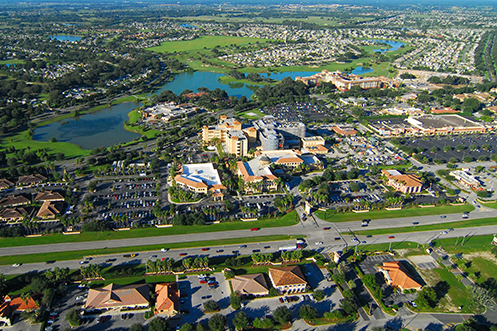News on state-to-state relocation often notes that Florida gains residents as part of a broader domestic US migration trend. Recently it was noted that Florida is gaining even more residents due in part to the impact of the COVID-19 pandemic. Several factors are driving this domestic migration trend, including:
- Availability of jobs and future job growth
- Corporate relocations
- Retiring workers moving to warmer climates
- Desire for lower costs of living
- Seeking lower tax environments
Many states in the Northeast and Midwest are losing residents to Florida. A review of tax filings shows many new Florida residents hail from the Tri-State region of New York, New Jersey, and Connecticut, as well as Massachusetts and Illinois. Comparing these factors between states illustrates why Florida gains residents while other states lose residents.
New York versus Florida Tax Environment Helps Illustrate why Florida Gains Residents
High taxes are often cited as a major reason that residents depart New York. How high are New York taxes versus Florida taxes? Recent analysis shows New York is the state where residents pay the most in taxes.
In 2018 the US government put limits on individual state and local “SALT” tax deductions for income tax filing purposes. The $10,000 cap on SALT deductions can result in a significant increase in a resident’s federal tax burden. As a result, many high income residents have been fleeing high tax states. The situation has caused some state governments to try to enact workarounds to prevent this effect. However, the IRS is disallowing several of these workarounds. Only a limited number of workarounds relating to “pass-through entities” appear to be excluded from IRS disallowances.
In the case of New York and New York City, unless an individual can leverage some kind of pass-through entity to avoid the cap on SALT tax deductions, they may face many of the following taxes:
New York State Taxes
- Income tax
- Sales tax (goods and services)
- Property tax
- “Sin” tax (liquor, tobacco, gambling)
- Estate tax
- Motor Fuel tax (excise tax, petroleum business tax, petroleum testing fee)
New York City Local Taxes
- Income tax
- Sales tax (goods and services)
- Metropolitan Commuter Transportation District (MCDT) surcharge
In the case of Florida and Miami, it may not be easy to see why Florida gains residents, as individuals may face many of the following taxes:
Florida State Taxes
- Sales tax (goods and services)
- “Sin” tax (liquor, tobacco, gambling)
- Motor Fuel tax
Miami Local Taxes
- Property tax
- Sales tax (goods and services)
Major Differences between New York and Florida Taxes Shows Why Florida Gains Residents
There are some major differences in the tax situation between New York and Florida. These differences help explain why Florida gains residents while New York loses residents. In particular, Florida does not impose any state or local income tax. There is also no estate tax in Florida.
Additionally, the tax rates may be significantly different, such as in sales taxes. Sales taxes may include state, county, city, and other local taxing jurisdictions.
New York City versus Miami Sales Taxes
Comparing the rates for New York City and Miami:
New York City total sales tax rate: 8.875%
- City sales tax 4.5%
- State sales tax 4%
- MCTD surcharge 0.375%
Miami total sales tax rate: 7%
- County surtax 1%
- State sales tax 6%
As Florida Gains Residents, What Does This Mean?
There are several points to consider as Florida gains residents. The construction industry will continue to grow with job opportunities as housing, commercial, and infrastructure projects proceed. With a greater number of employees able to work anywhere with new corporate policies, local Florida employers may benefit from their proximity to a larger pool of local employees. There may be further shifts in political representation as the 2020 US Census takes note of Florida’s population growth and New York’s population decline.
What Should Employers do as Florida Gains Residents?
As Florida gains residents, employers should review their talent acquisition and retention programs to ensure they remain competitive in their market. Employers should consider the impact of employees relocating to Florida on current staffing as well as tax withholding considerations. Work from anywhere policies should be examined to ensure employees are encouraged to remain with the employer.
Conclusion
Global Mobility Solutions’ team of corporate relocation experts has helped thousands of our clients understand how to consider the impact of US domestic migration trends. As Florida gains residents, our team can help your company understand how to identify important issues that may impact talent acquisition and retention programs. We can also help your company understand if a relocation to Florida or a corporate headquarters relocation might be a future opportunity for corporate growth.
GMS was the first relocation company to register as a “.com.” The company also created the first online interactive tools and calculators, and revolutionized the entire relocation industry. GMS continues to set the industry pace as the pioneer in innovation and technology solutions with its proprietary MyRelocation® technology platform.
New SafeRelo™ COVID-19 Knowledge Portal
GMS recently launched its new SafeRelo™ COVID-19 Knowledge Portal featuring a number of helpful resources including:
- Curated selection of news and articles specific to managing relocation programs and issues relating to COVID-19
- Comprehensive guide to national, international, and local online sources for current data
- Program/Policy Evaluation (PPE) Tool for instant relocation policy reviews
Contact our experts online to learn how to position your company’s relocation program for success as Florida gains residents, or give us a call at 800.617.1904 or 480.922.0700 today.
GMS is not a CPA firm, and is not giving financial advice. Everyone’s financial situation is different; individuals and employers should consult their financial advisors prior to making any decisions.




